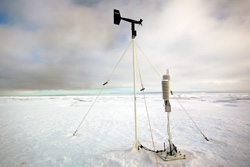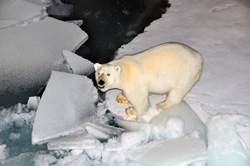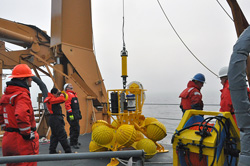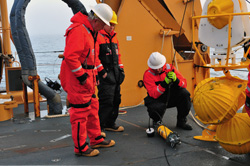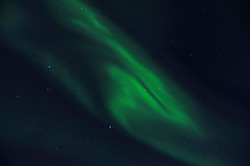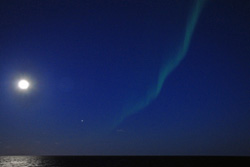Such a lot of effort went into the project by the National Science Foundation that funded the ship time, by Conoco Phillips that that purchased the met station, by the Coast Guard personnel who so expertly got us there, by Steve Roberts who so cleverly found the floe by parsing a welter of satellite imagery (much of it provided by the National Ice Center), by the technicians who assembled the thing in the first place and those who fixed it on the ice. Plus, there were so many organizational and logistical levels involved in its origination, so many different funding organizations Bob approached and whose cooperation he marshaled long before the equipment arrived in Barrow. “I’ve lost equipment before,” said Dr. Bob. “But this one hurts.” This ship needs to break off work and make for Dutch Harbor, four day’s steam away, tonight. So there’s no chance to go back to the ice station two days in the other direction. No, after all that, it’s just gone. So what happened to it? All he experienced hands aboard this vessel concur: Bear. A polar bear or two, perhaps the juveniles we’d seen earlier in the day, strolled over to have a look. Maybe they were attracted to that floe by all that fresh meat on ice liberty. You can almost picture it—first an exploratory sniff, a lap or two around it, another few sniffs to be on the safe side. It doesn’t move on its own, and it’s not edible. A strange and inscrutable object, but apparently not overtly menacing. A test with a paw the size of a dinner plate. Stand up on hind legs, give it a smack; make it move. Fun. That’s it, of course—It’s a toy! Let’s kick it around until we turn it into junk…. Then go find something else to do for amusement. The story of the met station’s demise, assuming bears destroyed it illustrates so exquisitely the difficulty of working in this environment—and exactly who owns the ice. There was another threat to data so diligently collected. Bob and the technicians had assembled a package of instruments mounted on a tripod—in fact they call it the “tripod”—and placed it on the seabed in 70 meters of water in Barrow Canyon. The centerpiece of the tripod was one of those Arctic winches, but something was wrong with the winch. It seemed able to travel up and down, but it wasn’t recording its measurements to the “logger.” Time being short—we simply had to head for Dutch Harbor, some 1,000 miles away by tonight—Bob was faced with one of those chief-scientist’s decisions. He could elect to leave the tripod on the bottom, hoping that the winch was still gathering data and just not delivering it to the logger. He had one spare winch aboard and since the tripod site was roughly on the Dutch-bound course west, he could pull the tripod, install the fresh winch, and redeploy the package. But what if the release didn’t release? Acoustic releases, a vital part of any mooring or instrument package in at-sea the business, work most of the time. However, depending on acoustics and electronics in a highly hostile and corrosive milieu, they sometimes don’t. In those instances, the procedure is to “drag” for the valuable instruments and their more valuable data by towing a grappling hook back and forth behind the ship, hoping to hook the lost gear without destroying it. But now there would be no time to drag. Working or not, the instrument would have to be abandoned. Those were the terms of Bob’s decision. He elected to pull the tripod and change out the winch. John lowered the transponder that talks to the release, and keyed in the “wake-up” call on the “deck box,” essentially a computer. So far, so good. The release was awake. There followed what he called “ten seconds of terror” between the release-code keystrokes and the response from the release itself agreeing actually to let go. It worked. The tripod popped to the surface, John and his team smartly changed out the Arctic winch, and back it went. By all electronic reports, it’s working fine. The final task before heading to Dutch Harbor was to deploy Josh’s last acoustic recording mooring (HARP). The first one remains among the missing, but he has been towing an array of hydrophones picking up, he thinks, bowhead sounds among others. Sharon, Brian, and the other fauna observers on the bridge are reporting whale blows in profusion now. Healy has been making good a remarkable 18 knots, a horse heading for the barn at high speed. It’s now noon local time on Friday, and we’re turned south around Point Hope, heading straight for the Bering Strait, 115 nautical miles away. We’ve a good chance to transit the strait in daylight. However, as we head south, the hours of daylight grow shorter, which seems counterintuitive, but soon night will descend on the Arctic and last some four months. You’ll hear the story of our passage through this legendary constriction between the Old World and New World, and see Rachel’s photos if visibility holds. That’s a big if in these latitudes. Last night the sun set, a perfect orange sphere off the bow, as the full moon rose astern. There was not a wisp of fog and nor a single cloud in the sky, the first such night since we left Barrow. We waited, this time with real hope, for what we’ve waited the last twenty nights—a glimpse of Aurora Borealis, the Northern Lights. I’ve seen them before in Greenland waters. The sky show is unforgettable, evoking childlike wonder and awe. Seeing the Aurora, it’s easy to see why the Inuit were animists. However, like certain other spectacles of nature, photos reveal the show better than words. At 1615 local time, we crossed the Arctic Circle southbound.
Last updated: September 28, 2010 | |||||||||||||
Copyright ©2007 Woods Hole Oceanographic Institution, All Rights Reserved, Privacy Policy. | |||||||||||||
